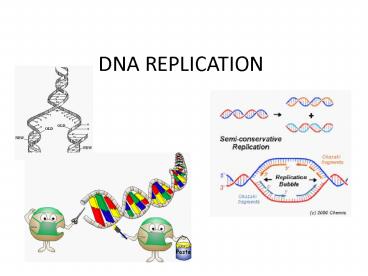DNA REPLICATION PowerPoint PPT Presentation
Title: DNA REPLICATION
1
DNA REPLICATION
2
(No Transcript)
3
(No Transcript)
4
- DNA gyrase the bacterial enzyme that relieves
the tension produced by the unwinding of DNA - DNA helicase enzyme that unwinds double-helical
DNA by disrupting hydrogen bonds - DNA polymerase I enzyme that removes RNA primers
and replaces them with the appropriate
deoxyribonucleotides - DNA polymerase III enzyme responsible for
synthesizing complementary strands of DNA - DNA ligase enzyme that joins DNA fragments
together by catalyzing the formation of a bond
between the 3 hydroxyl and a 5 phosphate group
on the sugar-phosphate backbone - Primase enzyme that builds RNA primers
5
(No Transcript)
6
- Leading strand
- Complementary strand is built toward replication
fork - Built continuously
- Primase needs to add only 1 RNA primer that DNA
polymerase will use to build toward the
replication fork
- Lagging strand
- Complementary strand is built away from
replication fork - Built discontinuously in small sections (Okazaki
fragments) - Primase continuously adds primers as replication
fork travels along DNA molecule - Gaps between Okazaki fragments are joined by DNA
ligase
7
(No Transcript)
8
- Replication fork
- Where the enzymes replicating a DNA molecule are
bound to the untwisted, single-stranded DNA
- Replication bubble
- Formed when two replication forks are in close
proximity to each other, resulting in a bubble of
single-stranded DNA between them.
9
Why eukaryotic DNA has multiple replication
origin sites
- Due to its size
- It would take too long for DNA replication to
occur if replication started at one end of a DNA
molecule and proceeded to the other end. - The speed of DNA replication for the humans is
about 50 nucleotides per second per replication
fork. But the human Genome can be copied only in
a few hours because because many replication
forks take place at the same time (multiple
initiation sites).
10
(No Transcript)
11
DNA polymerase III, and DNA pol I act as quality
control by proof reading the new strands. When
mistakes occur either enzyme can function as an
exonuclease.
12
(No Transcript)
13
(No Transcript)
PowerShow.com is a leading presentation sharing website. It has millions of presentations already uploaded and available with 1,000s more being uploaded by its users every day. Whatever your area of interest, here you’ll be able to find and view presentations you’ll love and possibly download. And, best of all, it is completely free and easy to use.
You might even have a presentation you’d like to share with others. If so, just upload it to PowerShow.com. We’ll convert it to an HTML5 slideshow that includes all the media types you’ve already added: audio, video, music, pictures, animations and transition effects. Then you can share it with your target audience as well as PowerShow.com’s millions of monthly visitors. And, again, it’s all free.
About the Developers
PowerShow.com is brought to you by CrystalGraphics, the award-winning developer and market-leading publisher of rich-media enhancement products for presentations. Our product offerings include millions of PowerPoint templates, diagrams, animated 3D characters and more.

